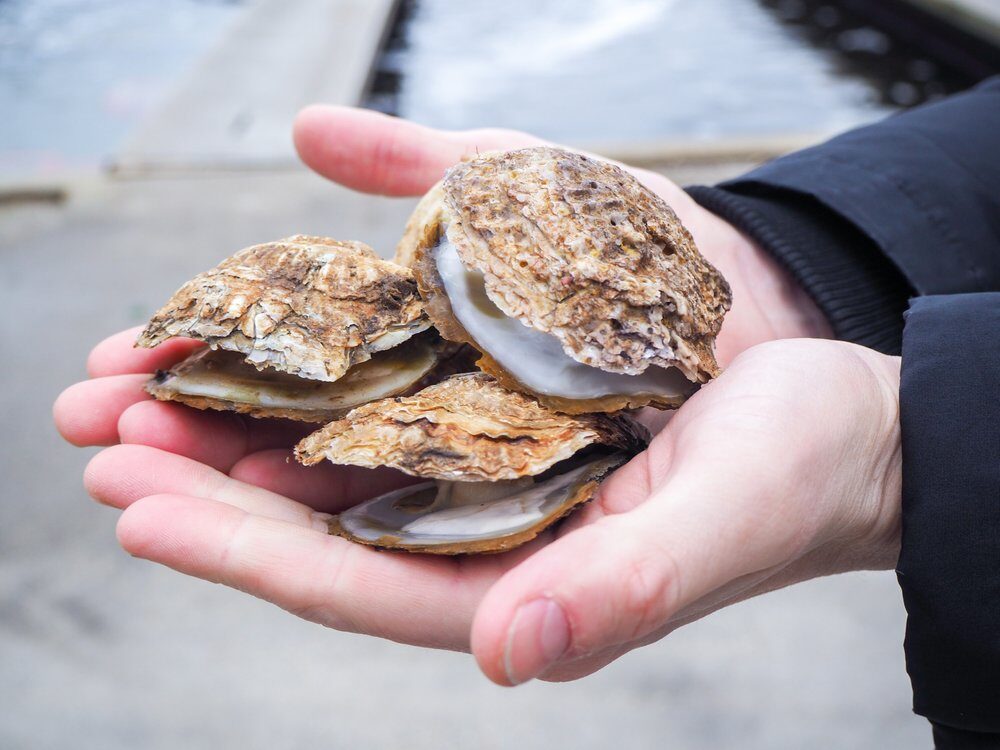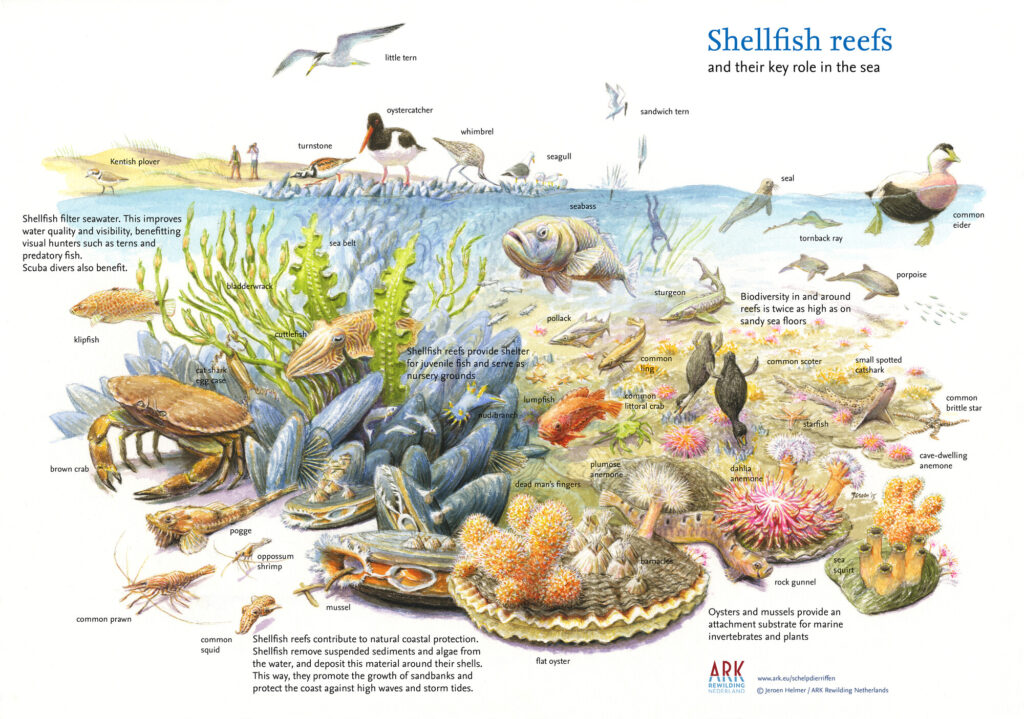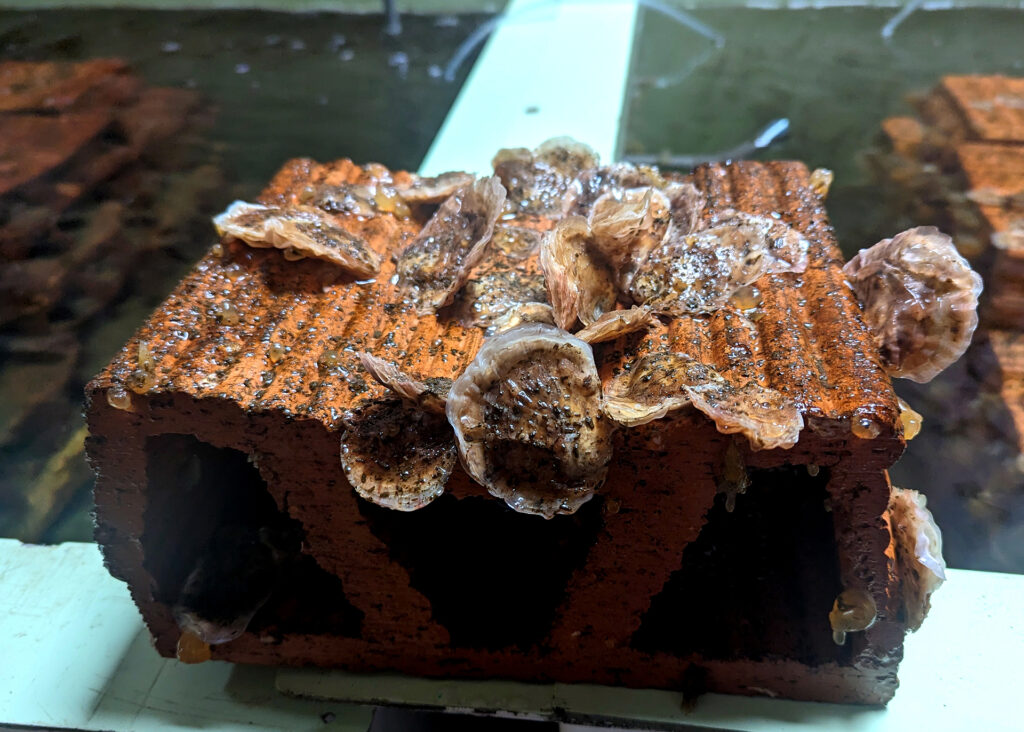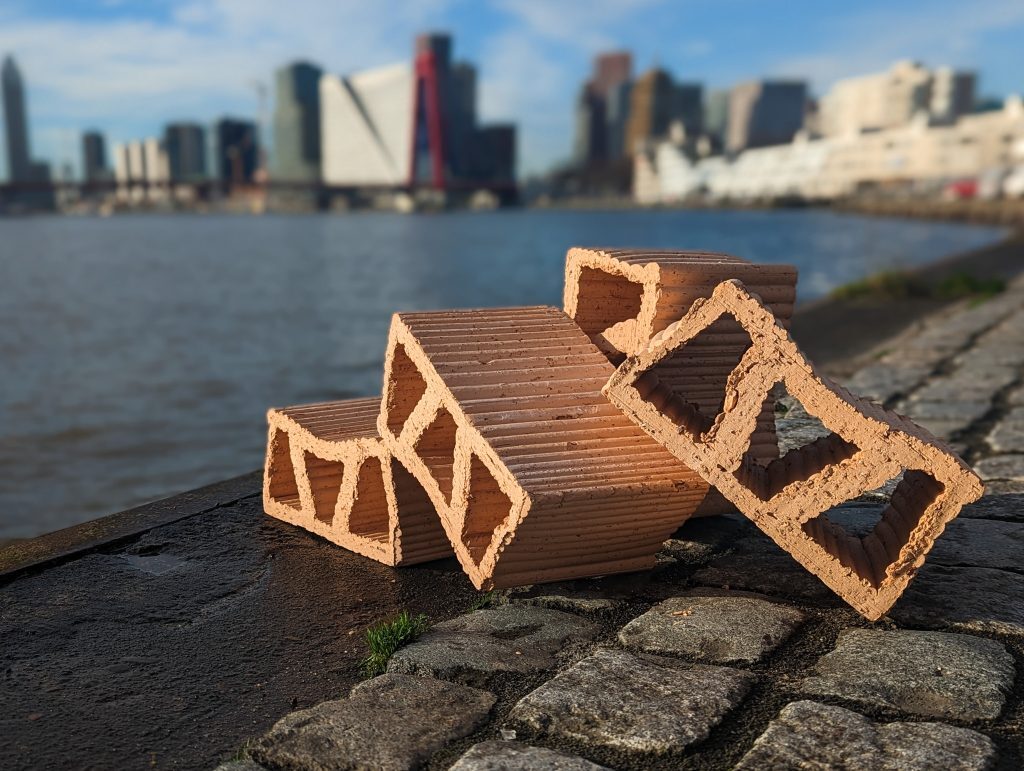Pioneering start-up Oyster Heaven is working to restore populations of European native oysters across the North Sea and beyond. A loan from Rewilding Europe Capital will help the business scale up operations, with the restoration of this keystone species set to deliver wide-ranging benefits to people and nature.

A keystone species on the edge
The European native oyster (Ostrea edulis), also known as the European flat oyster, is a bivalve mollusc that is found in shallow, subtidal coastal and estuarine areas. It is a keystone species in marine ecosystems, forming an important component of local food webs. When they are present in large enough quantities to form dense aggregations known as “reefs”, they can provide habitat for a variety of other aquatic species, stabilise shorelines, and reduce coastal erosion and sedimentation.
Oysters also have an amazing ability to clean seawater, with a single oyster filtering up to 200 litres of seawater every day. By improving water clarity they can enable species such as seagrass to grow at greater depth, while their filter feeding can remove excess nutrients from water – in particular nitrogen – which in high levels can cause harmful algal blooms, oxygen depletion, and fish mortality. While nitrogen is abundant naturally in the environment, excess amounts in the ocean are largely caused by the runoff of agricultural fertilisers.
Until the nineteenth century, extensive European native oyster reefs existed along many coasts in northwest Europe. Since then, however, the population has declined by 95%, with native oyster reefs now one of the most threatened marine habitats in Europe. Overfishing has been the major cause of this decline, with habitat loss, disease, pollution, and invasive non-native species all contributing factors. In the North Sea, where oyster reefs used to cover 20 to 30% of the seabed, the European native oyster is now considered functionally extinct.

Funding impactful oyster regeneration
Founded in 2021, Oyster Heaven is a Rotterdam-based startup and nature conservation organisation whose central mission is to regenerate oyster reefs at scale across the North Sea and beyond. They aim to reintroduce 5 million oysters in Europe and the United States in 2024 – using oyster species native to both geographical areas – and to have regenerated 100 million oysters by 2030. It is anticipated that this will lead to significant improvements in marine biodiversity, water quality, and waste management across a range of industries.
To help Oyster Heaven realise its mission, Rewilding Europe Capital – Rewilding Europe’s enterprise loan facility – has loaned the startup 100,000 euros. The money will be used to bridge a financial gap and fund an oyster restoration initiative in the Rhine-Meuse-Scheldt Delta area of the Netherlands. By the end of this initiative, 4 million oysters will have been restored on the seabed, with this number expected to at least double after 10 years of natural population growth.
“The total number of actively restored European native oysters is only in the hundreds of thousands right now,” says Oyster Heaven’s founder and business lead George Birch. “So what we’re doing is orders of magnitude bigger. Complemented by our work at other sites, this will be most the impactful oyster restoration initiative in Europe.”
The Evolution Of Oyster Reefs from Oyster Heaven on Vimeo.
A pioneering process
To enable oyster restoration at an unprecedented scale, the Oyster Heaven team have developed “Mother Reefs”, which will act as a substrate for oyster regeneration. The reefs, which have proven to be highly effective in tests, are composed of multiple clay bricks. Each brick is pre-loaded with 100 baby oysters (called spats), which are raised in hatcheries, before it is planted on the seabed by local fishermen. Oyster restoration sites are deliberately located in areas exclusively used for crab and lobster potting, or for seaweed aquaculture, which means bottom trawling is either forbidden or physically impossible.
Oysters are highly gregarious, meaning that juvenile oysters prefer to settle where other juvenile oysters have already settled. They naturally choose to settle on other live oysters, or old shells from dead oysters. Depending on the restoration initiative in question, there is an option to make the clay bricks of Oyster Heaven’s Mother Reefs biodegradable. As they gradually break down in sea water, the thriving populations of oysters these bricks support will end up growing on top of a substrate made up purely of other oysters.

Unique, cost-effective and scalable
Using Oyster Heaven’s Mother Reef system, the cost of restoring reefs is estimated to be around 0.25 euros per oyster. This compares very favourably with other oyster restoration initiatives, such as those involving the restoration of limited oyster numbers around offshore wind turbines, where costs can be as high as 1000 euros per oyster. The clay bricks of the reefs are produced in traditional brick factories, which means they can be manufactured quickly and cheaply anywhere in the world.
“The real innovation here is in terms of logistics,” says George Birch. “The Mother Reef bricks come on pallets that can fit perfectly into containers, which maximises the use of space. We can move the bricks around easily, put them into settlement tanks for the oysters to attach themselves, then onto the back of fishing boats for deployment, without a human needing to touch them. Nobody else is doing anything like this.”

Financial sustainability
Most marine conservation initiatives depend on philanthropy and funds, which are often hard to find. This can limit their impact. This is why Oyster Heaven has created an impact-based business model aimed at making oyster restoration financially sustainable, through the sale of nitrogen and biodiversity credits.
“I have long been obsessed with finding a way to get mainstream finance to invest in the health of our oceans,” says George Birch. “Oyster Heaven is the opportunity to make this happen. Today, countries are in various stages of recognising the value of the benefits that nature provides. Oyster Heaven is preparing for a society willing to pay for the benefits oyster reefs can provide.”
Scaling up marine rewilding
To date, rewilding has mostly been associated with terrestrial ecosystems. However, as the crises of biodiversity loss and ecosystem degradation extend into the marine realm, the idea of rewilding the sea has emerged as a critical and revolutionary approach to ocean conservation – one which can protect and enhance marine life and restore the ocean’s health, functionality, and resilience. It is for this reason that Rewilding Europe is looking to add marine landscapes to its growing landscape portfolio.

“The loan to Oyster Heaven aligns with Rewilding Europe’s desire to scale up marine rewilding across Europe, and to support innovative financial models that deliver rewilding impact,” says Rewilding Europe Conservation Finance Expert Daniel Veríssimo. “The restoration of oyster reefs can make a significant contribution to the rewilding of the ocean and I’m excited to see how Oyster Heaven’s work scales up moving forwards.”
The Rewilding Europe Capital team are interested in investing in both new and existing enterprises that can enhance rewilding impact across Europe – both on land and in the sea. If you own or know of a business that you believe would benefit from a partnership with Rewilding Europe Capital, or if you’d like further information, please contact Daniel Veríssimo.
